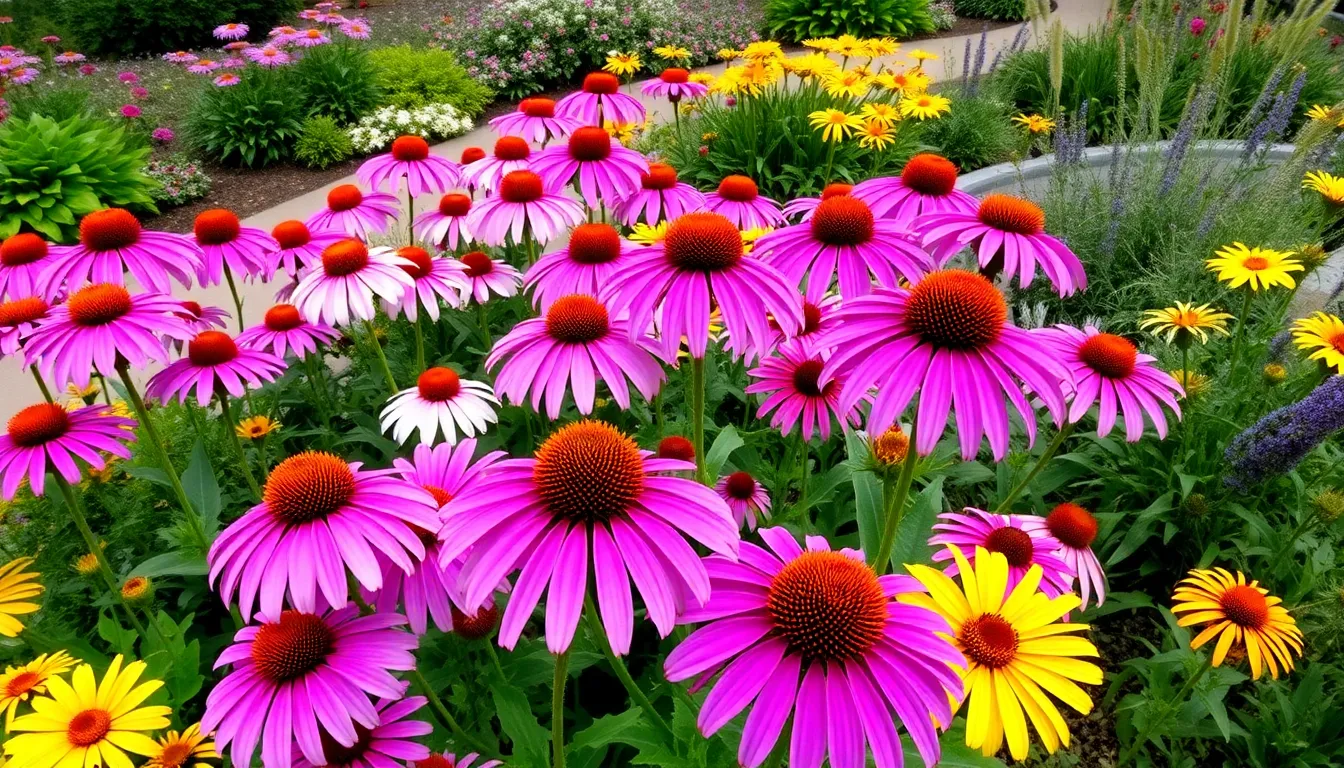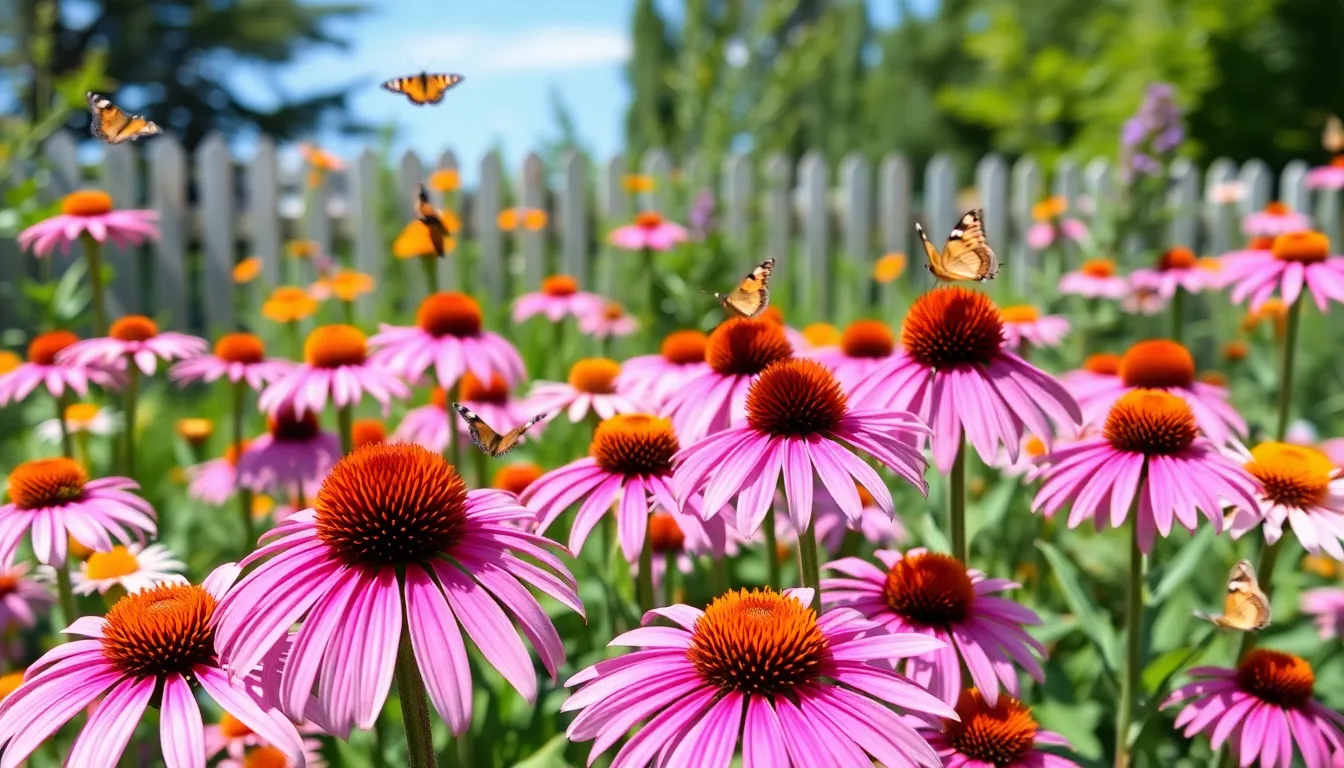Imagine stepping into a garden bursting with vibrant colors and delightful blooms, where coneflowers stand tall and proud like nature’s own cheerleaders. These resilient perennials not only add a splash of joy to any landscape but also attract butterflies and bees, making your outdoor space a buzzing haven of life. Who wouldn’t want a garden that doubles as a party for pollinators?
Designing a coneflower garden is like creating a masterpiece—each flower is a brushstroke on the canvas of your yard. With a little creativity and some expert tips, anyone can transform an ordinary space into an extraordinary floral retreat. So grab your gardening gloves and let’s dive into the world of coneflower garden design, where beauty meets practicality and every petal tells a story.
Coneflower Garden Design
Coneflower gardens offer numerous advantages that enhance both beauty and functionality. They contribute significantly to local ecosystems while providing vibrant colors and unique shapes.
Attracting Pollinators
Coneflowers excel at attracting essential pollinators. Bees, butterflies, and hummingbirds find these blooms irresistibly appealing. Such gardens boost pollination rates in the surrounding areas, promoting healthy plant growth. Pollinator populations increase, supporting biodiversity in urban and rural settings. Moreover, coneflower gardens create a lively atmosphere, enhancing the overall environment for visitors and residents alike.
Enhancing Aesthetic Appeal
A coneflower garden transforms outdoor spaces into visual masterpieces. Bright pinks, purples, and whites create stunning contrasts that draw the eye. Diverse heights and forms add depth and texture, making gardens visually dynamic. Planting coneflowers in clusters enhances the impact even further, enriching garden layouts. Seasonal changes in color and shape offer year-round interest, ensuring beauty regardless of the season. The right design can elevate a yard, turning it into a delightful retreat for relaxation and enjoyment.
Key Elements Of Coneflower Garden Design

Designing a vibrant coneflower garden involves careful selection and arrangement of plants. Key elements enhance both aesthetics and functionality, creating a lively habitat for pollinators.
Plant Varieties To Consider
Choose from a variety of coneflower species to achieve a dynamic garden. Echinacea purpurea offers classic purple blooms, while Echinacea alba showcases white flowers. Echinacea tennesseensis provides a unique yellow hue, contributing to visual diversity. Consider planting Echinacea ‘Green Envy’ for its distinctive greenish blooms. Select resistant varieties to thrive in local conditions, ensuring year-round interest and attraction for pollinators.
Layout and Spacing Best Practices
Arrange coneflowers in clusters for maximum impact and cohesiveness. Keep spacing between plants at least 18 to 24 inches apart, allowing for air circulation. Create layers by planting taller varieties in the back and shorter ones in the front. Utilize pathways to enhance accessibility and create visual flow throughout the garden. Incorporate companion plants, such as daylilies or ornamental grasses, to complement coneflowers and attract additional pollinators.
Maintenance Tips For Coneflower Gardens
Maintaining a healthy coneflower garden requires consistent care and attention. Focus on crucial aspects like watering, fertilization, pruning, and deadheading to promote growth and vitality.
Watering and Fertilization
Watering ensures coneflowers thrive, especially in dry periods. Soil should remain moist but not soggy. It’s beneficial to water at the base of the plants to prevent fungal diseases. Fertilization plays a role in enhancing blooms. A balanced, slow-release fertilizer can boost growth when applied in early spring. Testing the soil pH is also wise before adding fertilizer, as coneflowers prefer a slightly acidic to neutral pH of 6.0 to 7.0. Avoid over-fertilizing, which can lead to lush foliage with fewer flowers.
Pruning and Deadheading Techniques
Pruning encourages new growth and maintains plant shape. Early spring marks the best time to cut back old growth. Deadheading is essential for prolonging blooming. Removing spent flowers prevents seed formation, redirecting energy towards new blooms. Gardeners should aim to deadhead regularly throughout the blooming season. This technique not only prolongs flowering but also enhances the overall appearance of the garden. Healthy coneflowers benefit greatly from these simple maintenance practices.
Seasonal Considerations
Seasonal changes significantly impact coneflower growth and garden design. Understanding these elements helps in planning a thriving garden.
Spring Planting Strategies
Spring marks the ideal time for planting coneflowers. Focus on selecting healthy, robust seedlings to ensure thriving blooms. Consider spacing plants 18 to 24 inches apart to facilitate growth and airflow. Choose a location that receives full sunlight, as this encourages maximum flowering. Mulching around the plants aids in moisture retention while minimizing weeds. With regular watering and a well-draining soil mix, these adaptable perennials take root quickly, setting the stage for a vibrant summer display.
Fall Preparation Steps
Fall preparation is crucial for the garden’s longevity. Begin by cutting back the foliage after the first frost to prevent disease. This maintenance step helps redirect nutrients to the roots. Additionally, applying a layer of compost enhances soil quality for the following growing season. Monitoring for pests during this season ensures healthier plants come spring. Protecting coneflower crowns with mulch provides insulation against harsh winter conditions. These preparation steps contribute to a robust, well-established garden that flourishes year after year.
Conclusion
Creating a coneflower garden is an enriching experience that not only beautifies outdoor spaces but also supports local ecosystems. By carefully selecting and arranging these vibrant perennials, gardeners can cultivate an inviting habitat for pollinators while enjoying year-round visual interest.
With the right maintenance practices in place, coneflowers can thrive and provide a stunning display of color and life. Embracing creativity in garden design allows for unique expressions of style while contributing positively to biodiversity. A well-planned coneflower garden stands as a testament to nature’s beauty and the joy of gardening.

